FOOD & WATER

Oliver collecting edible moss. Image by Heidi Dammann
In these essays Oliver covers the vegetable possibilities from his Alaskan lands, including plants used for remedies and the collection of water.
EDIBLE PLANTS & LICHENS
Caribou, rabbits, spruce hens, and other animals are important basic foods that you can get off the land, but plants play a big role in nutrition as well.
As a child I helped my parents pick wild berries. In Alaska, the main berries we picked were blueberries and cranberries. We tried to put up eleven gallons a year of berries, which equated to something like a half cup serving a day.
Blueberries
Some years blueberries were so scarce that they weren’t worth collecting, so whenever we had a good year, we tried to put up extra. When the picking was plentiful, it didn’t take long to gather five gallons with a spruce root dipper and a good basket.
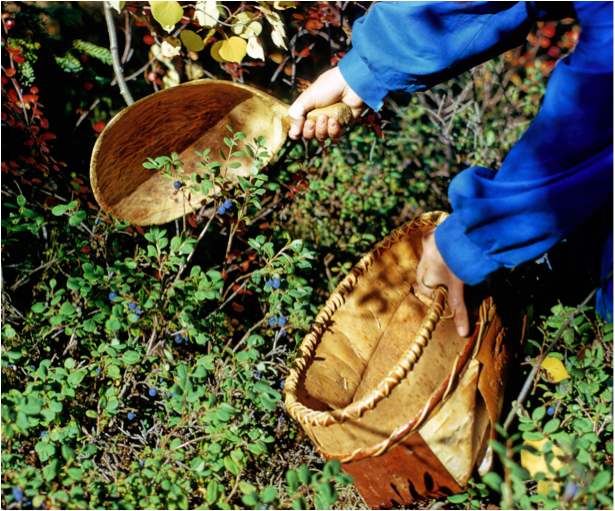
Oliver’s daughter, Dorene Cameron Schiro, using a hand-carved spruce root dipper to propel berries into a waiting basket. Image by Lorene Cameron
We’d stop from time to time, find a place with a breeze, and pour the berries from one container to another, allowing the wind to winnow out the stems and leaves. If there was no wind at all, we’d wait until we were in the boat on the return trip to winnow.
Sometimes I also used a big towel as a cleaning device. I sewed wide hems along each of the four edges and slid a birch stick into each one. The sticks on the short sides of the cloth kept the side pieces spread apart and were short enough to give the cloth a hammock shape. The lower one was a bit shorter than the upper one so that the cloth at the lower end formed a little pouch.
I’d prop up the upper spreader stick and pour a few blueberries onto the top end of the towel. Then I’d run my fingers underneath the lower end of the cloth to raise it to let the berries roll out of the pouch, over the spreader, and into a container.
Any leaves and spiders and sticks that the wind didn’t blow away when we winnowed the berries stayed on the cloth. If I found unripe berries that I didn’t want, I’d use a feather or a wingtip to flick them free. Between the winnowing and running the berries down that towel chute, the berries ended up clean.
Every once in a while I’d tip the whole chute over, stand it on edge, and thump the bottom of the cloth to knock off the accumulated stems and leaves.
Blueberries get juicy and wet when they’re ripe or when they get hit by frost. Then my towel system doesn’t work so well. Winnowing doesn’t either, so I pick them by hand and keep them clean in the field. Have an educated tongue when you eat them; avoid rotten or spoiled ones.
When you store blueberries, mash them thoroughly so that they’re covered with juice to the surface, or mold will grow around the top as they settle. I usually used a stick that had a foot on it, and mashed each new layer as I filled the barrel or container. Then I’d cover them with several layers of coltsfoot leaves that I’d wilted in hot water, tucking the leaves in around the edges. These leaves also acted as a mold deterrent. Then I’d put the container into the cold hole until freeze-up. [A cold hole is a hole dug into the ground where the soil is always cool, and then covered with an insulating lid].
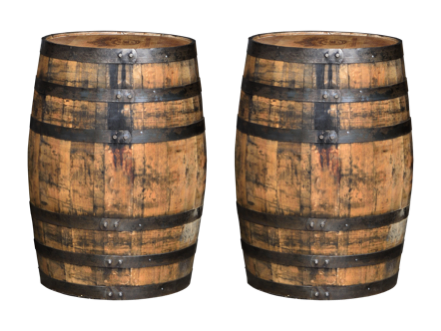
Small wooden barrels like these can be used for storing berries. (Image credit 55)
A traditional barrel isn’t always the best way to store blueberries because it gets wider as it goes down. Many people prefer to put the berries into quart jars with sugar and then store them in the cold hole. [Another trick is to pour seal or peanut oil on top of the blueberries, whether they are in a barrel or in jars. The oil spreads as the berries settle, keeping them sealed. When it gets cold, peanut oil congeals to the point that it can be easily lifted as a separate piece, and used in baking.]
When the weather got cold enough for those berries to begin to freeze, I’d take off the layer of leaves and clean up the mold around the edges. Mashed berries with a lot of juice freeze pretty hard, so when I wanted to eat some, I had to chip them out of the container with the point of a sturdy knife.
I also used to dry blueberries and cranberries for longer storage.
Cranberries
I could usually count on finding cranberries, depending on the season. They’re good keepers. I was usually a year ahead on storing them, and some years I ended up giving quite a few away.
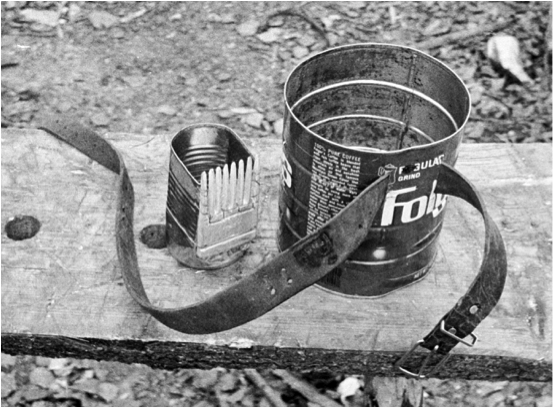
Oliver’s cranberry picking outfit. The smaller can with the comb was the picking can. He wore the larger can at his waist, dumping the berries from the picking can as it filled.
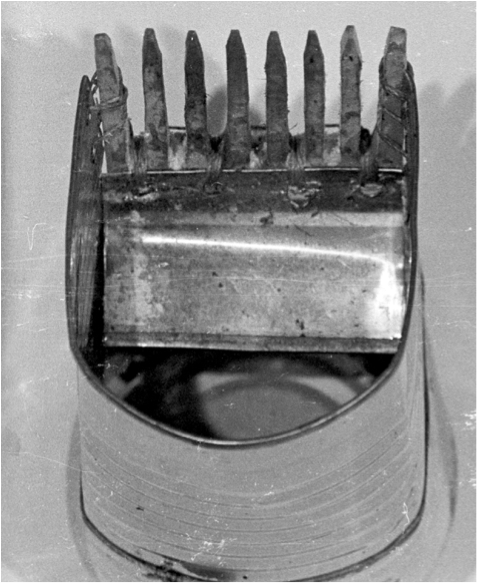
He’d slide the wooden comb, attached to the picking can, horizontally on the ground to pick the berries from their stalks, directing them into the can. The picking can had a folded-down flap inside, behind the comb, to keep the berries from rolling back out. Images by Curt Madison
Cleaning cranberries can be rather tedious. I used some hardware cloth in a frame. It’s probably less than 1/4 inch mesh. One edge was not fastened to the frame and hung down a little. I’d dump a bucket of cranberries onto that hardware cloth. The bigger berries would run down the hardware cloth and over that free edge into a basket. The stems, the smaller berries, and a lot of chaff would fall through the mesh. Then I’d use a feather to scrape some of the berries out into the open where I could see them and pick out the larger chaff before I put the cleaned berries into a storage container.
Cranberries picked by hand rather than with the rake often required very little cleaning.
Reindeer Moss
Reindeer moss is a high quality carbohydrate. It’s edible, and I think of it as part of my food supply. You can eat it raw, but it’s very acidic. I soak it with ash water or baking soda to neutralize the acids. You can also let it soak in plain water, squeeze it out, change the water, and repeat two or three times to leach the acid. Often, after the last soak, I put hot water on the moss, almost cooking it. Then I spread it out to dry.
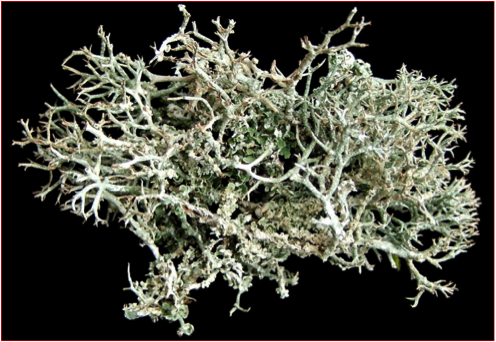
Reindeer moss is a lichen, Cladonia rangiferina. (Image credit 56)
The nice thing about reindeer moss and lichens is that if you keep in mind where you saw them in the summertime, you can always go back and pick them in the wintertime. You may have to shovel the snow away with your snowshoe, and that can be a lot of work if you have to get rid of 2-3 feet of snow, but plant nutrition can be hard to come by in winter.
Rock Tripe
Rock tripe is another type of lichen. It has a big, somewhat fleshy leaf-like growth, and it grows on the ground or on logs. It’s quite edible but needs the same kind of treatment as the reindeer moss.
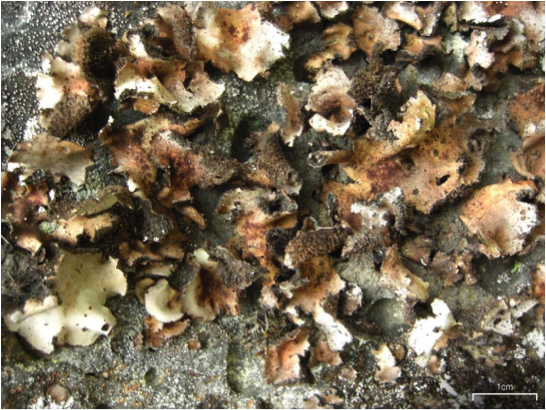
Frosted Rock Tripe. (Image credit 57)
If you’re hard up, these lichens are some of the most edible natural foods that you can find. They’re digestible and they’re plentiful. The Franklin Expedition depended on them when they were starving. [The Franklin Expedition was a British expedition that became icebound in the eastern Canadian Arctic in 1845, with the eventual loss of all hands.]
Willow Leaves
Some willow leaves are good to eat, and some are not so good because they get too bitter. When they come out in the spring and are still not too big, you can taste them to see which ones are more edible and pick those.
I had several willow patches around my place. It was hard for me to stand up and reach them, so I’d cut off a whole bunch of new leaves and little stems at the top and take them home. That way I could sit down in comfort, pick the leaves off, and dry them.
Once they dried, I crumbled them. Sometimes I just mashed them down into a bag. More recently I’ve put them through different grinders that worked very well. I could run them through there and they’d come out in powder form. I’d add the powder to whatever food I was eating, just to add some plant matter. Sometimes I put it into cooked food—added to oatmeal or another food. Willow is thought to have pain-relieving qualities.
I usually kept No. 10 cans of dried carrots, green beans, and celery on hand.
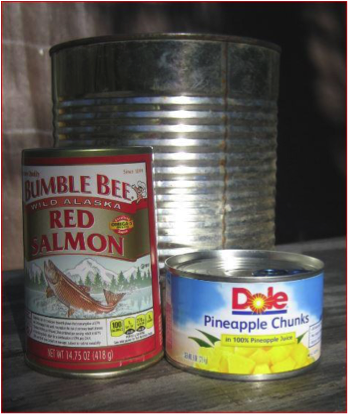
Number 10 can (without label).
Image by Ole Wik
I could grind them and mix them together, or I could scoop them out and add them to oatmeal or soup.
Birch Sap
In the springtime I collected birch sap and bark. Birch sap is a refreshing drink, freshly drawn from the tree. It also boils down nicely into a syrup.
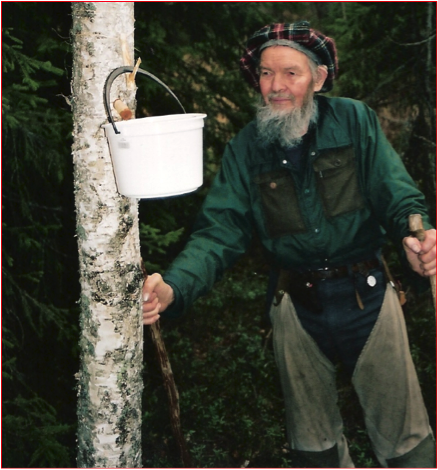
Oliver and birch sap bucket, Norway. Images by Heidi Dammann
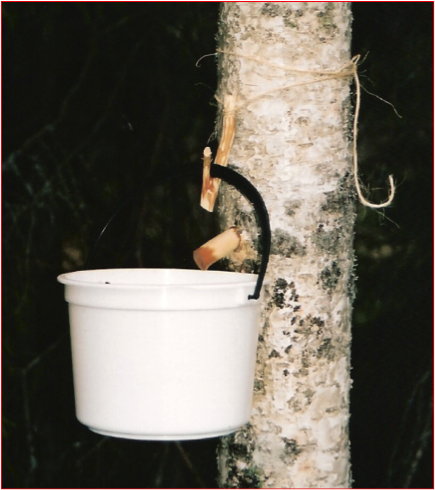
A plug is inserted into a hole in the trunk, and the sap drips into the bucket. In order to take advantage of the short season, it’s good to set out multiple buckets so that you will get sufficient sap for drinking and for boiling down into syrup.
There is a historical record of a famine in Norway or one of those northern European countries. People ground up the inner bark of birch trees, mixed it with wheat flour, and used it for cooking or baking.
FOODSTUFFS
In Elmer Kreps’s book, Camp and Trail Methods, he gives a list of which foodstuffs he used, and how much. He had a good system figured out, using quite a few dried fruits and a variety of other items.
I probably took fifty pounds of oats and twenty-five pounds of cornmeal when I first went out to the lake to stake my land. I also took several No. 10 cans of dried green beans and celery, as well as dehydrated carrots, so I had some vegetables.
I also took salt, pumpkin pie spice, raisins, currants, prunes, and dried apples. I had dried cranberries and dried blueberries that I had put up myself.
I don’t eat as most people do and haven’t for a long time, so my idea of food was necessary would not be practical for everyone. Some people would want to make bread or pan bread, or eat sugar, but I don’t think I took flour or sugar out with me. I depended on oats and cornmeal.
I would dry my own meat to take out to the lake with me. When I was preparing to leave for the lake homesite, I made quite a bit of pemmican, and also dried meat that I had ground up very fine and packed solidly in a plastic bag inside of a cloth bag, so that air was not mixed with it. [Air can break down dried meat. See Oliver’s essay, “How to Dry Meat and Make Pemmican.”] I also counted on getting fresh meat, even if it was just a squirrel or a spruce hen here and there.
I also took two No. 10 cans that I had refilled with fat. I can’t remember if it was lard or beef tallow. Some people would want to take oil instead.
For most of my time living in Alaska, I was eating quite a bit of meat and fat, but not so many carbohydrates. When you’re eating a lot of meat, you can’t make up for the missing carbohydrates by upping your intake of meat—you have to get the extra calories from fat. People tend to eat too much meat, because it feels more similar to how you feel when you’re full of carbs, but that’s a mistake, as eating too much protein in the absence of carbohydrates and fats is energy-inefficient and can lead to health issues. It’s better to eat a balance of protein and fat.
A carbohydrate confection that I quite often like to make is equal parts dried apples, raisins, and fresh cranberries, cooked together until the apples are mushy. I try to avoid getting too much water in it, and I let it steam to get rid of some moisture if needed. Then I mix in some pumpkin pie spice. It makes a good dessert.
I got food poisoning once, when I was single and batching [living alone, cooking for oneself]. I didn’t have a refrigerator, and I let food sit out too long, and I got sick. The next day I wasn’t worth much, but I got over it.
I don’t remember my wife or kids ever getting sick from spoiled food. Off and on someone would get queasy from eating too much fat, but that’s not the same as food poisoning. Strong tea is supposed to help with fat queasiness, but I didn’t find it helped me. I usually had some cranberries on hand. Just two or three of them would help the queasiness if I had eaten too much fat.
I used vinegar if I ever consumed questionable meat. If you eat meat that is a little bit strong and you begin feeling sick, drink vinegar right away. It makes a dog out of you, in the sense that a dog’s stomach acid is remarkably strong and can tolerate even fairly spoiled meat.
I’ve eaten dirt before. I used to keep soil and sand from the outside of the house in a little jar. I’d spread a little on my food sometimes when I wasn’t feeling good, and it did seem to help. I’ve assumed that it helped balance me out because of minerals in the soil. Dogs know about that, too. I have had dogs that would have a little dirt pried loose from the rest of the ground at certain places along the trail, and they’d snatch a mouthful every time we passed that spot.
When I was living in Norway, I’d give my hosts, Heidi and Rein Dammann, a list of groceries, and they would bring them out to me. I used to order several pounds of butter at a time. Heidi wanted to know how I preserved butter in the summertime. I told her I rendered [melted and clarified] it to get rid of the milky water that’s in it. Butter that’s been clarified like that, and then put into an airtight container, will keep a lot better than it does when it has all that moisture in it.
Fats and Oils
Fats and oils play an important role in the subsistence diet. Many of the natural food sources available in rural Alaska regions are animal-based (such as fish, caribou, rabbit, bird, seal, and whale meats) and thus are high in protein, and sometimes fats. When eating a high-protein diet with few carbohydrates, it is important to consume enough fat for a healthy metabolism. Fats also have a thermogenic effect as they are metabolized, helping to keep the body warm in the cold climate.
One time I went hunting upriver with a friend, Ronald Barr. We walked a few miles to a lookout where we soon saw a small herd of caribou within shooting distance. We crawled on the riverbank and shot all of them.
The days were short, so we were in a hurry. We worked hard and fast, gutting the caribou and pulling them together. We planned to get them the next day with a dog team. By the time we finished, I was hungry, and Ronald was too. We found a place out of the wind among some trees where we could settle for a snack.
I had a sack full of pemmican [a mixture of fat and dried, powdered meat, see Oliver’s essay “How to Dry Meat and Make Pemmican”]. Ordinarily my sack of pemmican would have been enough food for me to stay out overnight. I ate a little bit, but Ronald finished the whole works.
The next day I met his wife, Evelyn, at the post office. She asked what I had given Ronald to eat the day before, because when he’d gotten home, he hadn’t had any appetite for the big supper she’d made for him after his day out! Fat is a surprisingly filling food when combined with protein, as in pemmican.
My pemmican was half-fat and half-meat protein by weight, which is a very rich food. Surprisingly, eating that much of it didn’t seem to bother Ronald. If he felt a little queasy or sleepy from eating so much fat, he didn’t show it. [The Inupiaqs have a word for a sleepy or disoriented reaction after eating a great deal of fat—niqinnguuliq.]
I used to carry high-fat food with me, especially when I was out on a boat. You get more energy from a single gram of fat than you do from a single gram of protein or carbohydrate.
All animal fats are an important source of food here, but seal oil [a traditional food for the Inupiaqs] was something I had to learn to like. Eventually I had a craving for it.
The first time Ole came to dinner with my family, he’d only been in the country for a few days. Lorene [Oliver’s wife] brought out a jar of black meat [half-dried bearded seal meat] in seal oil. It was a special treat, but Ole wasn’t yet up to eating seal oil. It’s an acquired taste.
Ole said that later on, after he’d gotten a taste for Inupiaq foods, he craved seal oil when he was hungry for niqipiaq. [Niqipiaq, “real food,” refers to Inupiaq food, as opposed to nalaugmiutak, “white man food.”] The Inupiaq ladies loved to feed him their delicacies from the coastal spring hunt—black meat, half-dried trout, muktuk [whale skin with blubber attached], all stored in sweet, fresh oil.
If you eat a lot of the traditional fats like seal oil, your body becomes a heat-generating machine. I’d sometimes eat so much seal oil at dinnertime that I’d sweat at night. Tommy Douglas, a Alaska native, once told me that if he ate a good breakfast with lots of seal oil, he could be out hunting all day long and never get cold.
Inupiaqs who grew up eating a high-fat diet were accustomed to it, and they could eat a lot more fat than I could.
WATER
Anywhere you live, you need to have a source of good water. I used three sources at my homesites: roof runoff, water from the lake or the river, and melted snow.
Roof Runoff
I had a high cache with a metal roof that was suitable for catching clean water.
I dug a shallow pit on the downhill side of the cache, threw the dirt up along the edges, and lined it with a tarp. The pit caught the drip running off from the roof and created a pond when it was raining or snow was melting.
The water would get about 18 inches deep, even with some loss to wind. Altogether, the pit reservoir held about 200—300 gallons. Sometimes it tasted all right and sometimes it didn’t, depending on what was on the roof and how often it rained. The dogs drank out of it, and so did the squirrels. I used that runoff water for laundry or irrigating my garden.
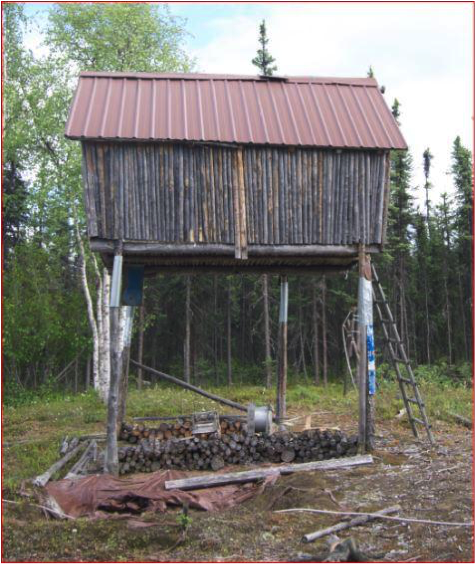
Oliver’s water reservoir and collection trough. Image by Dyre Dammann
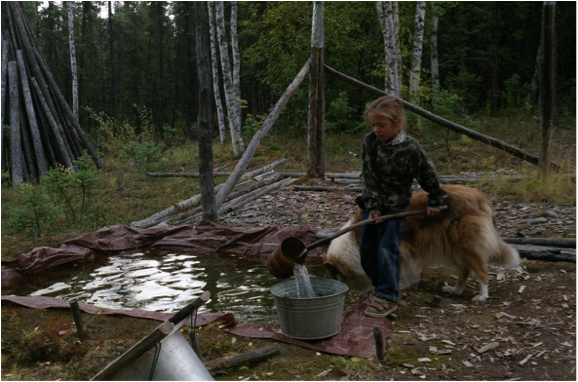
Sat Sarbat Khalsa fetches water on laundry day,
using a dipper that Oliver made out of a No. 10 can.
Image by Devta Khalsa
My other cache had a sod roof. I covered it with a tarp tied to the floor poles. On one side of the cache, the water or snowmelt ran down and dripped into a trough. On the other side I put a barrel or five-gallon buckets under places where the water tended to concentrate.
Lake Water
For drinking and cooking, I hauled water from the lake. I ordinarily boiled it before I drank it because there was Giardia out there. [Giardia is a genus of protozoan parasites that colonize and reproduce in the small intestines of several vertebrates. Affected animals release infective cysts into the water. Individuals who ingest the water may suffer violent diarrhea, stomach or abdominal cramps, and nausea.]
For hauling, I used a toboggan-like sled that could carry a lot of freight. I’d made it out of a couple of old plastic sleds that had been worn out by my neighbor’s kids. I overlapped the back end of one of the sleds onto the front of the other one. The finished sled was about half again as long as the original plastic ones, close to 6 feet.
I used that sled mostly for hauling water jugs, but also to move other items from the landing to the house. It pulled nicely on a wet trail or damp ground or even bare ground. Sometimes I pulled it myself, but usually I used the dog.
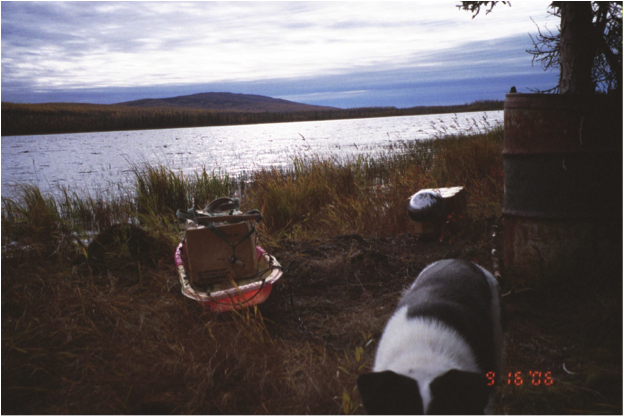
Plastic sled at the lake landing. Image by Tonya Schlentner
I also used a dog to pack water from the lake. Dogs use a different set of muscles when they’re packing than what they use for anything else, so I usually didn’t load more than 30 pounds, though I once had a dog that weighed sixty-five pounds and could carry forty pounds at a time—about five gallons.
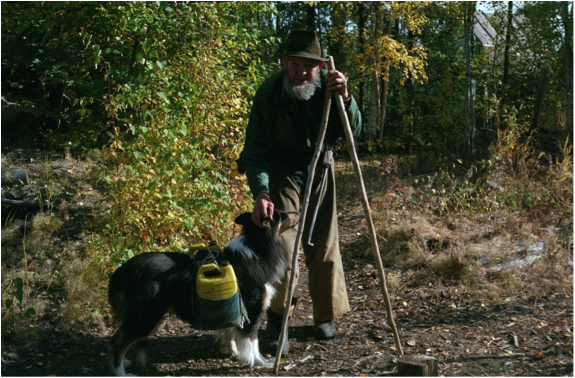
Devta Khalsa’s dog carrying two gallons of water. Image by Devta Khalsa
Snow
Freeze-up was the hardest time of the year to get water. The ice on the lake was too thin to support your weight, but you still had to break through it to get to water. Once the snow came, it was a lot easier to melt it for water.
Sometimes we’d get a good fall of snow before a long clear spell. If you cut down into a snowbank and got a cross section of the snow layers, you can see definite horizons with darker colored, dirty snow where dust and soot from wood smoke had fallen.
I rarely wanted snow for laundry, but I did need it for drinking and cooking in winter. To collect the snow, I’d dig a hole down through the deepest snowdrift I could find. I’d shovel out between the layers, discard what was dirty, and look for a layer 6-12 inches thick that had fallen during one major storm.
Snowdrifts built up around my buildings, but the best place to get good snow was among the trees. Often there were so many spruce needles and twigs that I needed to strain the water through a cloth or a clean T-shirt before I could use it. Even then it didn’t always taste good.
I’d collect the snow in a bucket or a dishpan. I tried to get clean snow that was close to the ground, where it was older and more crystallized. A bucket of that kind of snow gave more water than a bucket of the fluffier snow nearer the top.
Since a bucket is narrower at the bottom than it is at the top, snow will slide down as it begins to melt. Initially, hard-packed snow won’t slide down on its own. You can push it all the way down with a big spoon or a stick, or you can pour a couple of cups of water over the snow. Once you get some water in the bottom of the bucket, you can keep adding more snow until the bucket is full. The snow melts more quickly once it is immersed in the water.
In the springtime it was difficult to get to the lake because the trail would get mushy. I’d fill a couple of 30-gallon galvanized metal garbage cans with snow. That gave me extra water to use until the snow melted and the trail improved.
I had a neighbor who didn’t have any garbage cans. He’d lay out a tarp, prop up the edges on a framework of logs, and shovel it full of snow to collect water.
Traveling
I very seldom carry water when I’m out and about. One time I was out and stopped to eat a bite in a swampy area where the ground was soft and the moss was deep. In a place like that you can usually find a hole with some water in it. The water will be brownish from lying with moss and will taste like tundra tea, but I’d rather drink some of that than water from a lake where there are beaver and other animals that can spread Giardia. I usually carried a kettle and a metal cup, so wherever there was a little trickle of water, I could dip it, put it in the kettle, and boil it to make sure it was safe.
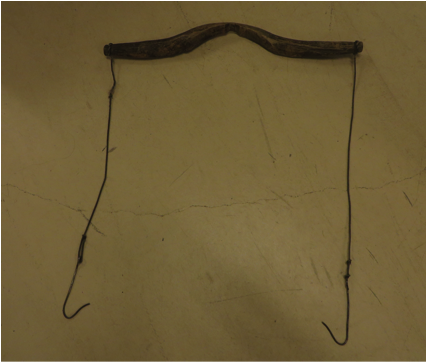
Oliver designed a yoke to help him carry water from the lake. Image by Dorene Cameron Schiro
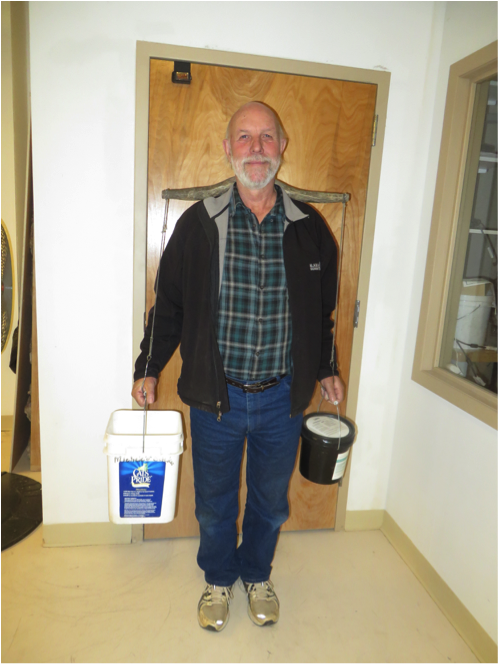
Richard Cameron demonstrates use of the yoke, with buckets. Image by Dorene Schiro
GARDENING
I liked to have a garden filled with plants that were easy to grow in the environment where I lived.
A garden under spruce trees will have acidic soil. I had a procedure that sweetened the soil. I’d clear a little plot of land, remove all the superficial moss, and leave whatever layer of black topsoil existed.
I’d bring loads of grass from down by the beaver dam before its seeds were all ripe, and spread it on my plot. Then I’d add some ashes, and pretty soon, new grass began growing on the plot.
The next spring I’d make the plot into a garden. I’d spade up an area and pile the soil into beds. I’d gather more topsoil and leaves from under willows. My beds were spaced about 16 inches apart so I could work from either side of them.
Then I’d gather leaves and grass from around my place, including the dog yard, as well as whatever else there was that would decay rapidly. I put all this into the trenches between my beds.
Little by little, that material in the trenches would rot. After a couple of years it turned into compost, even though it was down in the cool ground. Then I’d take it out of the ditches, pile it on the beds, and use it as fertilizer.
I also collected urine. I put it in a plastic jar with little holes and sprinkled it on the garden soil. [Urine contains a great deal of nitrogen, a natural fertilizer and soil enhancer. It also helps to speed the composting process.]
In addition to the trenches, I had a composting pile where I put grass, leaves, kitchen waste, and plant material from the previous year’s garden—anything of that sort. I’d turn it a couple of times during the summer with a fork. Once the pile had decayed, I’d spread it on the bed and chop it in. Even if it hadn’t completely composted in the period of one summer, it would finish once I’d mixed it into the soil.
The main tool I used for gardening was an army surplus trenching tool, the kind that soldiers used to dig foxholes. I removed the original handle and replaced it with the root of a young birch tree. The root’s shape was more to my liking. Since I’m lazy, I kept the blade of the tool sharp by filing it on the inside edge.
The trenching tool was like a hoe or an adze, but with a deeper blade. If I pulled it just right, it would break the soil and lay it over, and it would cut roots that would have been tough to handle with an ordinary spade. More importantly, I could sit on a six-gallon plastic bucket with the lid on while I worked. In my later years I couldn’t stand while I turned the soil.
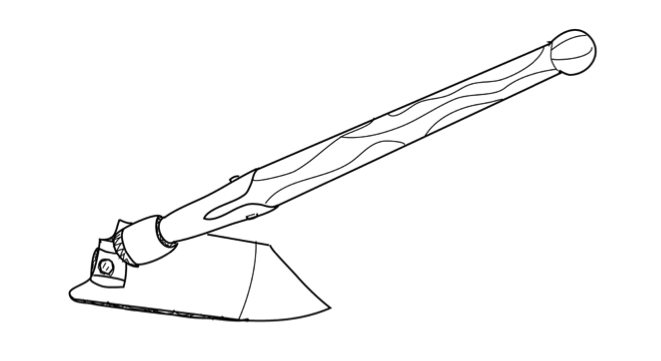
Entrenching tool. Drawing by Brady Wedman
My father taught me when I was young that when you start a garden, you always spade two blades deep. By digging deep, you bring up virgin soil that has more minerals in it. You bank up what you dig so you have a little mound. Then you step back and do it again, throwing the dirt against the bank you’ve started.
I try to avoid extra work, so I let fireweed and grass grow along the edges of my beds. Since those plants reach down deeper than some of the garden produce, they also bring up minerals and store them in their stalks and roots. I cut them off or spade them under, and that adds to the soil’s fertility.
At planting time, I never bothered to lay out my rows with a string and stakes—I’d use a 1-inch board about 6 feet long. I’d smooth the surface of the soil, push the edge of the board into the ground, and lay my seed in the trough it had made.
I’d push some soil over it with the same board and tamp it down lightly so the seeds would be in tight contact with the soil and get moisture right away. Then I’d slide the board along and repeat the process until the row was as long as I wanted it.
I made a frame that was 4 feet square and shaped like a pyramid. I covered it with plastic sheeting to make a small greenhouse, just to see if it helped. It made a big difference. The plants under it progressed much more quickly than my uncovered ones.
Over the years I grew a few conventional garden plants. I grew lettuce for a time. I could have started plants like cabbage and cauliflower indoors, hardened them off, and set them out later, but it didn’t seem to be worth it.
I’ve grown potatoes, but we usually had an early frost in August or September. That was a nuisance. They didn’t do so well when it frosted. To help against the frost, I drove some stakes into the ground some distance apart and placed a plastic cover over my plants. If the plastic touched the plants, the frost would go right through, but if it was up above them, it would trap enough heat to protect the garden.
My most successful crops were chickweed and lamb’s quarter. When they were fresh, I’d eat some of the lamb’s quarter and a lot of the chickweed. I didn’t plant it in rows—I sowed the seeds and raked the soil with a board to cover them up. The plants came up too thickly, so I’d thin them out and eat the thinnings for a salad.
As the plants got bigger, I kept nipping the leaves off at the tips, and ate them as salad all summer. Sometimes I’d pick whole leaves and boil them. If there was just too much of the plants, I’d spread them out on a rack and dry them for winter use.
I’d wait until the seed was ripe before I harvested the plants. I’d stick them in a paper bag and shake them around to get most of the seed off before putting the rest of the plant on the compost. During the winter I’d grind the seeds or cook them.
Chickweed and lamb’s quarter are both considered weeds, and I didn’t import them on purpose. There was a generous admixture of both lamb’s quarter and pigweed in some alfalfa seeds I’d bought for sprouting. The lamb’s quarter did very well, but the season was too short for the pigweed to produce new seed.
The plants colonized other parts of the garden, too, especially chickweed. If they weren’t too much of a nuisance, I let them grow. I could sow them in inferior soil and still produce a nutritious plant, but I worked hard to build up my soil. Both lamb’s quarter and chickweed are known to be nutritious. In fact, lamb’s quarter was raised in Europe as a farm crop—I suspect both for the leaves and the seeds.
Sometimes critters raided my garden, creating problems. To control mice, I put tin cans around the garden with some water or oil in them. Mice, exploring for food, would jump inside and drown. I didn’t like to have the dogs eat them, so I threw them into the stove.
To keep out rabbits, I built a fence around the garden by driving stakes into the ground, about 2-1/2 feet apart. Then I braided small, limber saplings back and forth between them and pushed them to ground level. I built a frame along the top to hold all the posts together.
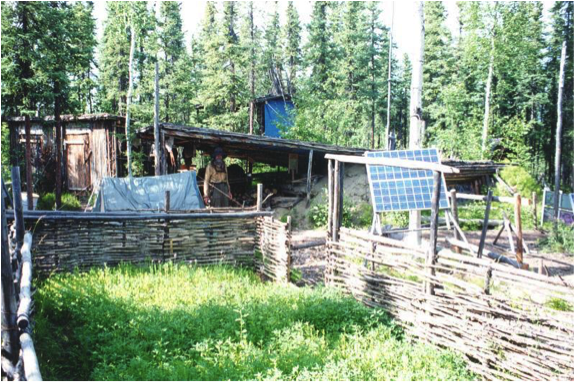
Oliver’s woven fence. Image by Dorene Cameron Schiro
In other gardens I had, I used a more conventional fence set-up, with a pole frame filled in with chicken wire.
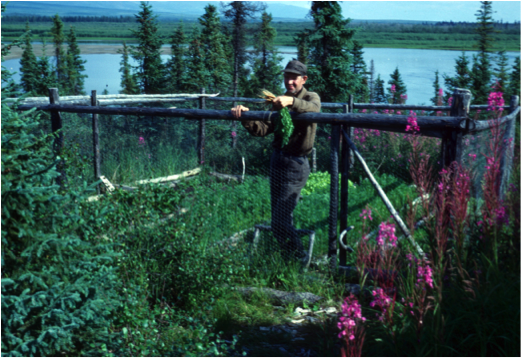
Oliver in his garden with chicken wire fence.
Image by Dorene Cameron Schiro
Now and then, I’d set snares to catch rabbits as they tried to get into my garden, and I caught quite a few of them in years when they were populous. I saved the hides and used them to make a blanket. [See Oliver’s essay, “Making a Rabbit Skin Blanket.”]
Birds can sometimes be a bother for gardeners, but I didn’t have a lot of trouble from them. I’d broadcast seeds late in the fall, shortly before snowfall, and birds would eat a certain amount of the seed that didn’t get buried as I raked the soil surface. There were a few birds in the garden in the summer as well, but they didn’t cause any great loss.
I haven’t had much trouble with moose, though they’ve waded across my garden once or twice in winter. The fence that keeps out the rabbits and the puppies isn’t high enough to keep out moose.
I once had a bear between the house and the dog yard. He was trapped because of the way I had arranged things. He didn’t want to leave.
My dog, Pack, who had long legs and weighed 65 pounds, handled that. He ran around the bear in a circle, just out of reach. The bear didn’t want the dog to get behind him, so he spun around. Finally he bolted. In his eagerness to get away, the bear jumped over my fence, into the garden, and out the other side.
HOME REMEDIES
Pitch salve
Pitch is an antibiotic healing concoction. You can put it on any kind of scrape, abrasion, cut, or chapped skin. I’ve used it on my lips when they’ve gotten cracked from being out in the weather.
You can collect pitch from pine or spruce trees. Hard pitch comes right off the wood, or you can scrape away the soft stuff that bleeds out of scars in the tree, which is a messy business.
The Inupiaqs make it in a five-gallon can. I usually make it in a number of throwaway tin cans, such as old stewed tomato cans.
Fill a can half-full and heat it up until the pitch melts. Then stir in some Vaseline, goose fat, bear fat, or whatever kind of fat you have. Start out the ratio with half pitch and half fat.
There will be a lot of residue. Strain the hot mixture through mosquito net or something similar, and let it set up.
The consistency should be similar to Bag Balm or Vaseline. [Bag Balm is a salve used to soothe irritation on cows’ udders after milking, but it’s also often used as a treatment for chapped and irritated skin on humans, too.] If the salve turns out too soft, you can reheat it and add some beeswax to stiffen it. If it’s too hard, add a little Vaseline or more melted fat.
Pitch salve doesn’t especially relieve pain, but it does protect against infection and promote healing. Most of the time I smear a little salve on a Band-Aid and put that over the sore area on my skin. I will also spread it over the injury and cover it with a loose bandage, because clothing will rub on the sore and salve will get on the clothing.
An Inupiaq in Kotzebue once told me that if I ever found anyDouglas fir that had streaks of wood that smelled like turpentine, he would like to buy some. His parents used it medicinally. They boiled it and made their children drink the broth as a means of preventing tuberculosis. It might very well have been effective; he seemed to think so.
Pitch gum
Sometimes you’ll find lumps of hardened pitch along trails where sleds or snow-gos [snowmobiles] have scarred trees, and also around the edges of burls. In the States and in Alaska, too, people used to deliberately scar trees to generate sap for making traditional birch bark canoes.
If I have a sore throat, I pry off marble-sized chunks of the birch pitch and chew it. It’s kind of crumbly and breaks into little chunks in your mouth. You keep on mouthing it and chewing it, and it gets softer with saliva and mouth heat. Pretty quick it comes together and makes a sort of chewing gum. It sterilizes your throat, and it’s quite soothing. I haven’t found anything better for a sore throat.
Quite often I found spruce pitch in Norway. If there was any that was big enough to pick off and save, I always did.
Stinkweed (Artemisia tilesii)
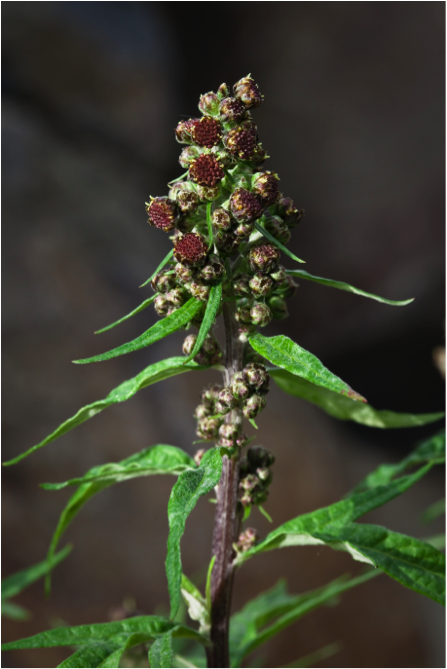
Stinkweed. (Image credit 58)
Stinkweed is the same species as sagebrush. I used it most often as dried leaves. For indigestion, I’d just take a wad of the dry leaves and start chewing.
Tamarack (Larix laricina)
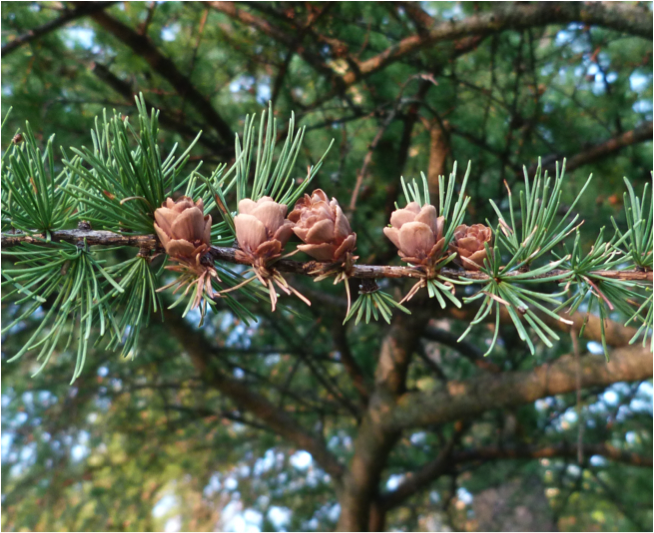
Tamarack foliage and cones. (image credit 59)
The inner bark of the tamarack tree is very astringent. It’s good for inflamed hemorrhoids or any bleeding.
When I had back surgery, the doctor didn’t want me to go home until spring, but I felt like I needed to get home before winter to take care of my place.
Once I was back home, I started having some problems. I had blood in my stool. I figured it was from my stomach, because I’d been having digestive issues of and on for a while. I cut a little tamarack tree, brought it in, made up a tea from the inner bark, and cooked it down to concentrate it.
Then I took a medical magnet that was negative on one side and positive on the other. I put that over the area where I thought the bleeding was, and at the same time I drank a lot of that super-strong tamarack tea. That took care of the bleeding right away.
I could have used fireweed, also known as firewort—it will do the same thing. But at that time of year, it was under the snow, and the tamarack was available above the snow, in a low area not far from the house.
Fireweed leaves (Epilobium angustifolium)
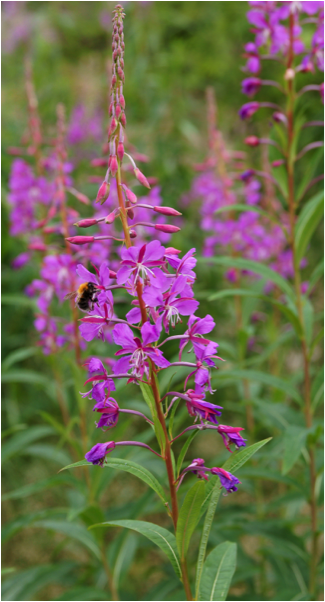
Fireweed. (Image credit 60)
Fireweed is good for bleeding and issues with the veins. One time when a lady was pregnant and had problems with hemorrhoids, I found some fireweed under a log. I gathered some, took it to her, and made a poultice out of it. That stopped her bleeding henorrhoids.
If I have diarrhea, I will get some fireweed leaves and chew on them. That takes care of it well. I use the green leaves. If they’re not available, I use the dry leaves that hang on the stalks.